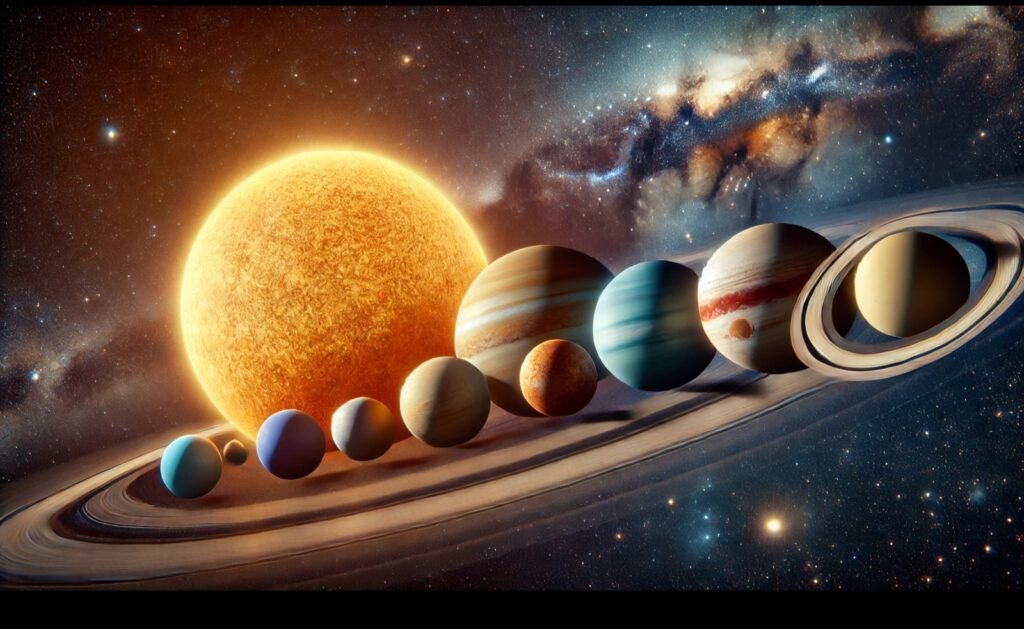Time is a fascinating concept when observed across different planets in our Solar System. Here on Earth, we define a “day” as the time it takes for our planet to complete one full rotation on its axis (24 hours) and a “year” as the time it takes to orbit the Sun (365.25 days). However, these values vary dramatically across the other planets.
Each planet experiences time differently due to its unique rotation speed, axial tilt, and distance from the Sun. Some planets have days that last longer than their years, while others have years that stretch across centuries in Earth terms. Gas giants like Jupiter rotate extremely fast, making their days incredibly short, whereas planets like Venus have days that last longer than an entire trip around the Sun.
Understanding Rotations and Orbits
To compare time across planets, we must understand two key concepts:
- Rotation Period (Day): The time a planet takes to complete one full spin on its axis.
- Orbital Period (Year): The time it takes for a planet to complete one full revolution around the Sun.
The relationship between these two factors creates unique planetary environments. Some planets, such as Mercury, have days that last longer than their years, while others, like Jupiter, complete a full rotation in under 10 hours.
Comparison of Days and Years in the Solar System
The table below provides an overview of the length of a day and a year for each planet in the Solar System, including Pluto:
| Planet | Length of a Day (Rotation Period) | Length of a Year (Orbital Period) |
|---|---|---|
| Mercury | 1,408 hours (58.6 Earth days) | 88 Earth days |
| Venus | 5,832 hours (243 Earth days, retrograde) | 225 Earth days |
| Earth | 24 hours | 365.25 days |
| Mars | 24.6 hours | 687 Earth days |
| Jupiter | 9.9 hours | 11.86 Earth years |
| Saturn | 10.7 hours | 29.46 Earth years |
| Uranus | 17.2 hours | 84 Earth years |
| Neptune | 16.1 hours | 164.8 Earth years |
| Pluto | 153 hours (6.4 Earth days) | 248 Earth years |
Notable Observations and Anomalies
- Mercury’s unique rotation: Mercury has a 3:2 spin-orbit resonance, meaning it rotates three times for every two orbits around the Sun. This results in a single solar day (from one sunrise to the next) lasting 176 Earth days.
- Venus rotates backwards: Unlike most planets, Venus has a retrograde rotation, meaning it spins in the opposite direction of its orbit. This results in a day longer than its year.
- Earth’s stable time cycle: Earth’s day and year are relatively moderate compared to the extreme variations of other planets, allowing for a stable climate and life to thrive.
- Mars’ similarity to Earth: Mars has a day (sol) just slightly longer than Earth’s, making it one of the most Earth-like planets in terms of time cycles.
- Gas giants have extremely short days: Jupiter and Saturn, despite their enormous sizes, complete rotations in just about 10 hours due to their rapid spin.
- Pluto’s long year: Because Pluto is so far from the Sun, a single year lasts nearly 250 Earth years—meaning a human could never live to experience even half a Plutonian year. It’s worth noting that Pluto is now classified as a dwarf planet.
Impact on Climate and Planetary Conditions
The differences in rotation and orbit influence a planet’s climate, weather patterns, and overall habitability:
- Fast-spinning planets: Jupiter’s rapid rotation leads to extreme weather patterns, including its famous Great Red Spot, a storm that has lasted for centuries.
- Slow rotation and extreme temperatures: Mercury’s long days cause one side to face intense heat while the other experiences freezing temperatures.
- Axial tilt effects: Uranus rotates on its side, leading to extreme seasonal variations where each pole experiences 42 years of continuous sunlight followed by 42 years of darkness.
- Short and long years: Neptune and Pluto have such long years that seasonal changes take decades to complete.
Astrobiology and the Search for Life
Understanding planetary time cycles is crucial in astrobiology—the study of life beyond Earth. A planet’s day length and year affect:
- Habitability: Short or extremely long days could create inhospitable temperature extremes.
- Potential for liquid water: Stable planetary conditions are essential for sustaining liquid water, a key ingredient for life.
- Future colonization: If humans ever colonize Mars or beyond, adjusting to different day-night cycles will be a significant challenge.
Celestial Mechanics and Timekeeping
The study of planetary rotations and orbits also helps refine our understanding of celestial mechanics. Scientists use these measurements to:
- Predict planetary motion and improve space navigation.
- Analyze past and future climate changes on planets.
- Enhance our models of how solar systems evolve over time.
Planetary Time Scales and Cosmic Exploration
Time is not universal—each planet experiences it differently based on rotation and orbit. While Earth’s 24-hour day and 365-day year feel natural to us, the diversity of time scales across the Solar System showcases the vast complexity of planetary dynamics.
Understanding these variations is crucial for planetary science, space exploration, and astrobiology. As humanity looks toward the future of interplanetary travel, adapting to new time cycles will be an essential part of exploring and colonizing other worlds.
From Mercury’s scorching long days to Pluto’s frozen centuries-long orbit, the study of planetary time offers valuable insights into how celestial bodies evolve and interact with their environments. As space agencies plan missions to Mars and beyond, timekeeping in space will play a key role in navigation, survival, and scientific discovery.

